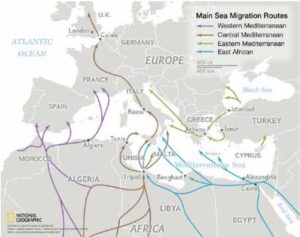Where Are We Going?
Migration Today
What Is the State of Migration Today?
As the world’s population increases, more and more people are on the move. As of 2020, roughly one in seven people on earth is estimated to have migrated at least once in their life.
In an increasingly interconnected world, every place and every person is affected by migration, whether you have moved or not.

MIGRATION BY THE NUMBERS
More than one billion people are migrants—roughly one in seven people on earth.
763 million people are internal migrants, who have moved within their country.
281 million people are international migrants, who have moved from one country to another.
Sources: World Health Organization Refugee and Migrant Health, 2021; UN Global Education Monitoring Report, 2019; UN World Migration Report, 2020

Source: https://www.nationalgeographic.com/news/2015/09/150919-data-points-refugees-migrants-maps-human-migrations-syria-world/
Share Your Story How is migration part of your community today? Are there new traditions or celebrations? Has the language or cuisine changed? Share your migration stories using #WorldOnTheMove
Where are people moving today?
Explore the flipbook below to discover where people are moving today and why.
We take place names for granted but maybe we should think again. Place names carry a lot of meaning, and change with history. Has “the Middle East” always been called that? Can you name the seven continents? Where did these names come from?

World Migration Routes People still travel from East Africa through the Middle East and West Africa through the Mediterranean on their way to Europe. They travel through South Asia around the Indian Ocean. And they travel north through Central America, where the first people in the region traveled south more than 14,000 years ago.
World Migration Routes
Today, people around the world follow many of the same migration routes our ancestors took.
Place Names
Can you name the seven continents? “America” comes from the name of an Italian mapmaker, and “Australia” comes from the Latin word for “south.” Whose point of view do these words reflect? What other names might the people living in these places or traveling through have used to describe them?

Mediterranean Routes
People still travel to Europe from Africa and Asia, as they have done for tens of thousands of years. Some of today’s migrants are fleeing conflict in countries such as Syria and South Sudan. Others are seeking opportunities in countries that once colonized theirs, such as migrants from the Gambia to Italy, or from Algeria to France.

Central American Routes
In recent years, migration in the Americas has followed two main patterns, both spurred by economic, environmental, and political challenges. People are moving from rural areas to big cities—Mexico City now has 22 million people, up from 3 million 40 years ago. People are also moving from Central American countries to cities along Mexico’s northern border with the U.S.

Musicians and activists gather at the U.S.-Mexico border for the annual Fandango Fronterizo Festival. On both sides of the wall, attendees sing, dance, and come together as a community. Photo by Charlie Weber/Ralph Rinzler Folklife Archives/Smithsonian Institution

Southeast Asian Routes
The first people arrived in Australia more than 65,000 years ago, traveling from South Asia along the edge of the Indian Ocean. Today, people fleeing natural disasters in Bangladesh and violence in Myanmar follow a similar route.

Rohingya children arrive on the coast of Bangladesh, where they are resettled in refugee camps. The Rohingya are a Muslim ethnic minority group, who have fled violence and persecution in neighboring Myanmar. Photo by LittlePerfectStock
What drives migration today?
Many of the forces driving migration today are the same issues that caused our ancestors to move, including:
- Poverty
- Conflict and violence
- Persecution
- Political instability
- Economic opportunity
- Competition for resources
- Natural disasters and environmental changes
- Reuniting families
Climate Change in Bangladesh
Bangladesh, located on the Bay of Bengal, is extremely vulnerable to the effects of climate change. Flooding and erosion have displaced many people from their homes. Among those impacted are hundreds of thousands of Rohingya, a Muslim ethnic minority group, who have fled violence and persecution in neighboring Myanmar.

A Rohingya girl, exhausted from seven days of walking from Myanmar, sleeps on the side of the road in Bangladesh, 2018. Photo by Nur A Mahajabin_Kahn

The feet of a young Rohingya boy who walked ten days from Myanmar to Bangladesh, 2018. Photo by Nur A Mahajabin_Kahn

People ride on rickshaws to cross a flooded street in Dhaka, Bangladesh, July 26, 2017. Photo by Sk Hasan Ali/Shutterstock.com